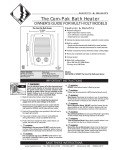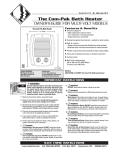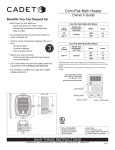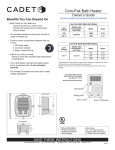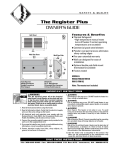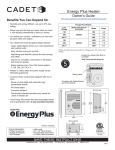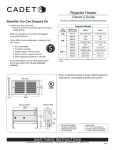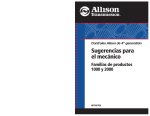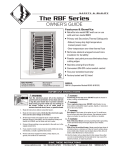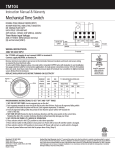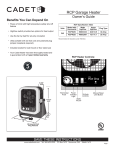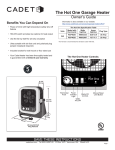Download Cadet The Com-Pak Bath Heater CB103T Troubleshooting guide
Transcript
The Com-Pak™ Bath Heater OWNER’S GUIDE FOR MULTI-VOLT MODELS Features & Benefits The Com-Pak™ Bath Heater 10” Width ■ Primary and secondary thermal safeguards • High temperature manual reset • Over temperature one-time thermal device 12 5/8” Height ■ Commercial grade steel element - painted to resist rusting ■ Built-in controls - Single pole thermostat - 60 minute timer ■ Powder coat paint process eliminates sharp cutting edges ■ Three year extended warranty on element and motor ■ Factory tested 1/2” Depth Tools Required: Phillips Screwdriver Straight Screwdriver Wire Strippers Utility Knife 4 11/2" Wood Screws 3 Insulated Wire Connectors 1 Strain Relief Connector ■ Multi-Volt configurations 120 or 240 Volt AC (1000 Watts) *Factory set at 240-Volts Models: CBC103TW or CB103T The Com-Pak Bathroom Heater IMPORTANT INSTRUCTIONS WARNING excessive lint or dust are present. Turn the electrical power off at the electrical panel board (circuit breaker or fuse box) and lock or tag the panel board door to prevent someone from turning on power while you are working on the heater. Failure to do so could result in serious electrical shock, burns, or possible death. 1. Read all instructions before using this heater. 9. WARNING DO NOT install where heater is likely to get wet. 10. WARNING Heater must be connected to a GFCI protected branch circuit. 11. WARNING Burn Hazard. This heater is hot when in use. To avoid burns, do not let bare skin touch hot surfaces. Use extreme caution when any heater is used by or near children or invalids. 12. WARNING Risk of Electrical Shock. DO NOT install the heater directly above bathtub or sink. DO NOT install in shower stall area (Manufacturer recommends a minimum 2 foot clearance). 13. WARNING Risk of Electrical Shock. Connect grounding lead to grounding wire provided. Keep all foreign objects out of heater. 2. Read all information labels. Verify that the electrical supply wires are the same voltage as the heater. 3. All electrical work and materials must comply with the National Electric Code (NEC), the Occupational Safety and Health Act (OSHA), and all state and local codes. 4. Connect the grounding pigtail (copper wire) provided in the wall can to the supply ground wire. 5. If you need to install a new circuit or need additional wiring information, consult a qualified electrician. 6. Protect electrical supply from kinks, sharp objects, oil, grease, hot surfaces or chemicals. 7. 8. WARNING Overheating or fire may occur. DO NOT install the heater in a floor, in the ceiling, below a towel bar, behind a door, or anywhere the air discharge may be blocked in any manner. WARNING Fire or explosion may occur. DO NOT install heater in any area where combustible vapors, gases, liquids, or 14. 15. WARNING Risk of Electrical Shock. Never place a switch where it can be reached from the tub or shower enclosure. WARNING Risk of Fire. Do not block heater. Heater must be kept clear of all obstructions: a minimum of 3 feet in front, 6 inches above and on both sides. Heaters must be kept clean of lint, dirt and debris. (See Maintenance Instructions). SAVE THESE INSTRUCTIONS 360-693-2505 Fax: 360-694-8668 P.O. Box 1675 Vancouver, WA 98668-1675 READ ALL INSTRUCTIONS AND SAFETY INFORMATION Installation Instructions Part One PLACEMENT: Install The Com-Pak Bathroom Heater (Model CB) vertically. Heater is not approved for horizontal or ceiling mount applications. CONTROLS: A built-in thermostat and 60 minute timer. (Note: Do not use with a wall thermostat). How do I install for new construction? STEP 1 Mount The Wall Can IMPORTANT! It is extremely important you verify that the heater is configured for the correct supply voltage. If replacing an existing heater, check the labels of the old heater and configure for the appropriate voltage. Hooking a heater configured for 240 volts to a 120-volt power supply will drastically reduce the heater’s output. Hooking a heater configured for 120 volts to a 240-volt power supply will destroy the heater. Connecting your heater to an incompatible power supply will void the warranty The CB Series heater REQUIRES A MINIMUM distance of 6 inches from adjacent surfaces and 41/2 inches from the floor. However, Cadet RECOMMENDS 12 inches from all adjacent surfaces and 12 inches above the floor for longer and cleaner performance. Heaters must be spaced at least 3 feet apart. Secure the wall can to the stud with 2 screws (See Figures 1 & 2). As an option, the rubber shim provided may be attached to side of wall can to square the wall can to the stud. How do I install in an existing wall? STEP 1 Figure 1 Face of wall can must extend 1/2 or 5/8 inch from face of stud to allow for thickness of sheetrock. Figure 2 Attach wall can to stud with screws through holes provided in wall can. Figure 4 Model CB STEP 2 Connect Supply Wires STEP 2 Connect Supply Wires Route the supply wire from circuit breaker to heater. Remove a knockout and attach the supply wire with a strain relief connector leaving 10 inch wire lead for later use. Connect supply ground wire to grounding pigtail in wall can (See Figure 3). Proceed to PART TWO. Route supply wire from circuit breaker directly to heater. Remove a knockout and attach the supply wire with a strain relief connector, leaving 10 inch wire lead for later use (See Figure 3). Connect supply ground wire to grounding pigtail supplied in wall can. STEP 3 Mount The Wall Can Insert wall can into opening; keeping wall can flush with wall surface. Secure can to wall stud with 2 screws through holes provided in can. Proceed to PART TWO Figure 3 Proceed to Part Two P.2 Cut Hole In Wall Cut a hole 8 inches wide by 101/4 inches high next to a wall stud. This heater REQUIRES A MINIMUM distance of 6 inches from adjacent wall surface and 4 1 / 2 inches from the floor. However, Cadet RECOMMENDS 12 inches from all adjacent wall surfaces and 12 inches from the floor (See Figure 4). Installation Instructions Part Two Multi-Volt Element Wiring Configuration: Refer to Figures 5, 6, 7 and 8 for desired voltage STEP 1 Determine Supply Voltage Heater must be connected to a GFCI protected branch circuit. Before installing the heater, it is extremely important you verify the heater is configured for the correct supply voltage. The Com-Pak Bathroom Heater is configured for 240-Volt operation by default. For 120-Volt installation you must reconfigure the heater wiring. Installing the heater without configuring for the correct voltage could destroy the heater and void your warranty. How to determine the supply voltage: If replacing an existing heater, check the labels of the old heater and replace using same voltage. For new construction, heater wires must be configured to the same voltage as the supply wires. If you need assistance, consult a qualified electrician. STEP 2 Select Proper Heater Voltage For 240-Volt configuration: The Com-Pak Bathroom Heater is configured for 240-Volt operation by default. For 120-Volt Configuration: To configure heater for 120-Volt, disconnect the blue wire from terminal D and connect it to terminal A. Then connect the loose red wire to terminal D. 240 VOLT POWER SUPPLY 120 VOLT POWER SUPPLY TIMER 3 6 JUMPER WITH INSULATED Q. D. 1 4 C MANUAL RESET HIGH TEMPERATURE LIMIT Figure 5 A D THERMOSTAT HEATING ELEMENT SPARE TERMINAL ON ELEMENT SHORTING BAR 1 Figure 6 C A B JUMPER WITH INSULATED Q. D. 4 HEATING ELEMENT B NON-RESETABLE HIGH TEMPERATURE LIMIT L1 MOTOR L2 C A B D A D C MANUAL RESET HIGH TEMPERATURE LIMIT MOTOR L2 THERMOSTAT 3 6 B NON-RESETABLE HIGH TEMPERATURE LIMIT L1 TIMER SPARE TERMINAL ON ELEMENT SHORTING BAR D Figure 8 Figure 7 CORRECT 240 VOLT CONFIGURATION WARNING Turn the electrical power off at the electrical panel board (circuit breaker or fuse box) and lock or tag the panel board door to prevent someone from turning on power while you are working on the heater. Failure to do so could result in serious electrical shock, burns, or possible death. WARNING Risk of Electrical Shock. Connect grounding lead to grounding wire provided. Keep all foreign objects out of heater. WARNING Risk of Fire. Heater must be kept clear of all obstructions: a minimum of 3' in front; 6" on both sides and above. Heaters must be kept clean of lint, dirt and debris. CORRECT 120 VOLT CONFIGURATION P.3 Installation Instructions How do I insert the heater assembly into the wall can? STEP 3 Install Heater Assembly Warranty is void if any material is sprayed on the element or blower. Use paint mask provided if walls are to be textured or painted. Turn heater assembly upside down (element down with motor facing you). Connect the supply wires to the heater wires with connectors (See Figure 9). Now rotate the heater so the element and the fan are facing you. The element should be at the top. Insert the bottom edge of the heater assembly into the half round slots in the bottom lip of the wall can (See Figure 10). [IMPORTANT: Push wires into bottom of wall can during insertion. Be sure that supply wires are not caught between motor and wall can, attach assembly at top with screw provided.] STEP 4 Install Grill Secure grill with the screws provided. Slide thermostat knob onto right control shaft extending through the grill and the timer knob onto the left shaft. Turn power on at the electrical panel board. Figure 10 Figure 9 Operation & Maintenance How to operate your heater 1. Once installation is complete and power has been restored, turn the thermostat knob fully clockwise. (The timer is on the left and represented by the symbol . The numbers indicate minutes). 2. When the room reaches your comfort level, turn the thermostat knob counterclockwise until the heater turns off. The heater will automatically cycle around this preset temperature. 3. To reduce the room temperature, turn the knob counterclockwise. To increase the room temperature, turn the knob clockwise. 4. For additional heat beyond thermostat setting, when room is occupied, turn timer to desired minutes. (The thermostat is on the right and represented by the symbol ). Heater will remain on until time expires, then control of the heater will return to the thermostat and the previous set-point setting. Maintenance As needed, or every six months minimum. 1.) WARNING! Before removing grill, turn the electrical power off at the electrical panel board (circuit breaker or fuse box). Lock or tag the panel board door to prevent someone from accidentally turning the power on while you are working on the heater. Failure to do so could result in serious electrical shock, burns, or possible death. 2.) Turn the heater thermostat all the way up and wait approximately 30 seconds. If the heater turns on, you have turned off the wrong circuit breaker at the electrical panel board. 3.) If heater does not turn on, proceed with next step. 4.) Remove screws and take off grill. 5.) Wash grill with hot soapy water and dry immediately. 6.) While holding fan (to avoid damage or bending), use a hair dryer or vacuum P.4 on blow cycle to blow debris through the top element (Do not touch element). 7.) Vacuum fan area without touching the elements. 8.) Replace grill and secure with screws. 9.) Turn thermostat to desired setting. 10.) Turn power back on at the electrical panel board. About the Heater Temperature-Limiting Controls The heater is protected by two temperature-limiting controls. The first is a high temperature manual reset limit control, designed to open the heater circuit when excessive operating temperatures are detected. The problem must be assessed and the limit must be reset to resume operation. Further protection is provided by a secondary over-temperature switch, which will open the heater circuit in severe over-temperature conditions, or in the event of component failure. If this occurs, the heater must be repaired or replaced. Resetting the Manual Reset Limit Control If the manual reset limit control has opened the heater circuit due to excessive operating temperatures, the heater will not work until the limit reset button is pressed. After allowing the unit to cool for at least 10 minutes and resolving the problem causing the limit to trip, (typically heater is blocked or needs cleaning) use a narrow object such as a ball-point pen to access the reset button through the heater grill. Press FIRMLY, and be sure to listen and feel for a click, indicating it has been reset. Note that resetting the manual limit control may not restore heater operation if a severe over-temperature condition has occurred. See the “Troubleshooting Guide” on next page for more information. IMPORTANT INSTRUCTIONS WARNING Turn the electrical power off at the electrical panel board (circuit breaker or fuse box) and lock or tag the panel board door to prevent someone from turning on power while you are working on the heater. Failure to do so could result in serious electrical shock, burns, or possible death. Troubleshooting Chart CONSULT LOCAL ELECTRICAL CODES TO DETERMINE WHAT WORK MUST BE PERFORMED BY QUALIFIED ELECTRICAL SERVICE PERSONNEL. Symptom Problem Solution Breaker trips immediately upon energizing heater. 1.Incorrect supply voltage. 2.Overloaded circuit. 3.A short circuit exists in the supply or heater wiring. 4.Defective circuit breaker. 1. Verify that supply voltage matches the heater rating. 2. The total amperage of all heaters on a branch circuit must not be more than 80% of the amperage rating of the circuit breaker and supply wire ratings. Use a lower wattage heater, or reduce the number of heaters on the circuit. 3. Shorted supply or heater wires may be accompanied by severe sparking. Inspect all supply and heater wiring insulation for damage. Do not reset the circuit breaker until all electrical shorts have been repaired. 4. Replace the circuit breaker. Heater fan operates, but does not discharge warm air. 1.Insufficient element temperature. 2.Incorrect supply voltage. 3.Element has failed. 1. Allow a few moments for element to reach operating temperature. 2. Verify that supply voltage matches the heater rating. 3. Replace element. 1.Heat loss from room is greater than heater capacity. 2.Thermostat is not functioning properly. 1. Close doors and windows. Provide additional insulation, or install a higher wattage heater or multiple heaters if necessary. (If your circuit is rated for more capacity.) 2. Wait for the timer to time-out or turn the timer counterclockwise to `0’ (The timer overrides the thermostat setting). If heater continues to run, adjust thermostat to its lowest setting. If heater continues to run (allow two minutes for the thermostat to respond), and room temperature is greater than 50 degrees; the thermostat requires replacement. Heater discharges smoke or emits a burnt odor. 1.Dust, lint or other matter has accumulated inside heater. 1. Clean heater (See "Operation & Maintenance" section for instructions). Element heats for a moment without the fan turning, then immediately stops heating. 1.Defective motor or internal connection. 2.Fan or motor jammed. 1. Heater or fan motor requires replacement. 2. Remove obstruction and press heater reset button (after allowing the unit to cool). Test heater operation--if reset button has been pressed (be sure to listen and feel for a click indicating it has been reset), but heater does not run, heater requires repair or replacement. Heater does not run. 1.Thermostat set too low. 2.Heater has tripped the manual high-temperature reset switch. 3.Heater has tripped the secondary over-temperature switch. 4.Power not on at the circuit breaker. 5.Broken or poorly connected wire(s) to heater. 6.Defective thermostat and/or timer. 1. Adjust thermostat to a higher temperature until heater operates (see Problem #6 if the problem persists). 2. Press the manual reset button (See "Operation & Maintenance" section for instructions). 3. A severe over-temperature condition has occurred. Repair or replace heater. 4. Turn on the correct circuit breaker in the main panel. 5. Turn off power at circuit breaker. Check supply wire continuity and proper connection to heater wires. 6. Repair or replace the heater. The entire heater, or any of its components may be checked for continuity to determine the cause of any problem. Heater will not shut off. Warranty LIMITED ONE-YEAR WARRANTY: Cadet will repair or replace any Cadet product, including thermostats, found to be defective within one year after the date of purchase. Extended Product Warranty LIMITED THREE-YEAR WARRANTY: Cadet will repair or replace any Com-Pak Bathroom Heater (CB) series element or motor found to be defective or malfunctioning from first date of purchase through the third year. These warranties do not apply: 1. Damage occurs to the product through improper installation or incorrect supply voltage; 2. Damage occurs to the product through improper maintenance, misuse, abuse, accident, or alteration; 3. The product is serviced by anyone other than Cadet. 4. If the date of manufacture of the product cannot be determined; 5. If the product is damaged during shipping through no fault of Cadet. 6. CADET’S WARRANTY IS LIMITED TO REPAIR OR REPLACEMENT AS SET OUT HEREIN. CADET SHALL NOT BE LIABLE FOR DAMAGES SUCH AS PROPERTY DAMAGE OR FOR P.5 CONSEQUENTIAL DAMAGES AND/OR INCIDENTAL EXPENSES RESULTING FROM BREACH OF THESE WRITTEN WARRANTIES OR ANY EXPRESS OR IMPLIED WARRANTY. 7. IN THE EVENT CADET ELECTS TO REPLACE ANY PART OF YOUR CADET PRODUCT, THE REPLACEMENT PARTS ARE SUBJECT TO THE SAME WARRANTIES AS THE PRODUCT. THE INSTALLATION OF REPLACEMENT PARTS DOES NOT MODIFY OR EXTEND THE UNDERLYING WARRANTIES. REPLACEMENT OR REPAIR OF ANY CADET PRODUCT OR PART DOES NOT CREATE ANY NEW WARRANTIES. 8. These warranties give you specific legal rights, and you may also have other rights which vary from state to state. Cadet neither assumes, nor authorizes anyone to assume for it, any other obligation or liability in connection with its products other than as set out herein. If you believe your Cadet product is defective, please, contact Cadet Manufacturing Co. at 360-693-2505, during the warranty period, for instructions on how to have the repair or replacement processed. Warranty claims made after the warranty period has expired will be denied. Products returned without authorization will be refused. Parts and Service Contact Cadet for information on Parts or Service. ©2007 Cadet Manufacturing Co. Printed in U.S.A. Rev. 01/07 #720050 The Com-Pak™ Bath Heater GUÍA DEL PROPIETARIO PARA MODELOS DE MULTIVOLTAJE The Com-Pak Bath Heater Características y Beneficios Altura de 12 5/8” Ancho de 10” Profundidad de 1/2” Herramientas necesarias: Destornillador Phillips Destornillador plano Pelacables Cuchillo multiuso Tornillos de 4 11/2"para madera 3 conectores de alambre aislados 1 conector de alivio de tensión ■ Protecciones térmicas primarias y secundarias • Reglaje manual de alta temperatura • Dispositivo térmico de sobretemperatura de operación única ■ Elemento de acero de calidad comercial pintado para resistir el óxido ■ Controles incorporados - Termostato de un solo polo - Temporizador de 60 minutos ■ Proceso de pintado con cobertura pulverizada que elimina los bordes filosos cortantes ■ Garantía extendida de tres años para el elemento y el motor ■ Probado en fábrica ■ Configuraciones de multivoltaje 120 ó 240 voltios de CA (1000 vatios) *Fijado en fábrica en 240 voltios Modelos: El calentador Com-Pak para baño CBC103TW y CB103T INSTRUCCIONES IMPORTANTES ¡ADVERTENCIA! Desconecte la electricidad en el tablero del panel eléctrico (caja de cortacircuitos o fusibles) y trabe o coloque un cartel en la puerta del tablero del panel para evitar que alguien vuelva a conectar la energía mientras se esté trabajando en el calentador. De lo contrario podrían producirse graves golpes eléctricos, quemaduras e incluso la muerte. vapores, gases o líquidos combustibles o exceso de pelusas o polvo. Podrían producirse explosiones o incendios. 9. WARNING NO lo instale donde el calentador se pueda mojar. 10. ¡ADVERTENCIA! El calentador se debe conectar a un circuito derivado con protección GFCI. 11. ¡ADVERTENCIA! Riesgo de quemaduras. Este calentador se calienta mucho cuando está en uso. Para evitar quemaduras, no lo toque con su piel descubierta. Tenga mucho cuidado al utilizar cualquier tipo de calentador en presencia de niños o personas inválidas. 12. ¡ADVERTENCIA! Riesgo de electrocución. NO instale el calentador directamente sobre la tina o lavamanos. NO lo instale en la zona de la ducha (el fabricante recomienda un espacio mínimo de 2 pies). 13. ADVERTENCIA! Riesgo de electrocución. Conecte el conductor de tierra al alambre de puesta a tierra suministrado. Evite que entren objetos extraños al calentador. 14. ¡ADVERTENCIA! Riesgo de electrocución. Nunca coloque un interruptor donde pueda ser alcanzado por el conjunto de la tina o ducha. 15. ¡ADVERTENCIA! Riesgo de incendio. No bloquee el calentador. El calentador debe mantenerse sin obstrucciones: un mínimo de 3 pies por delante, 6 pulgadas por encima y en cada costado. Los calentadores deben mantenerse sin pelusas, suciedad ni residuos. (consulte las instrucciones de mantenimiento). 1. Lea todas las instrucciones antes de usar este calentador. 2. Lea todas las etiquetas que contengan información. Verifique que todos los cables de suministro eléctrico sean del mismo voltaje que el calentador. 3. Todo trabajo y materiales eléctricos deben cumplir con el Código Eléctrico Nacional (“NEC”, por su sigla en inglés), con la Ley de Seguridad y Salud Ocupacional (“OSHA”, por su sigla en inglés) y con todos los códigos estatales y locales. 4. Conecte el alambre de tierra en espiral (de cobre) que viene en la cámara de pared al alambre de puesta a tierra del suministro. 5. Si se debe instalar un nuevo circuito o se necesita información adicional sobre el cableado, consulte a un electricista calificado. 6. Evite que los cables de suministro eléctrico se retuerzan o entren en contacto con objetos afilados, aceite, grasa, superficies calientes o sustancias químicas. 7. 8. ¡ADVERTENCIA! Podría producirse recalentamiento o un incendio. NO instale el calentador en el piso, en el cielo raso, bajo la barra de la toalla, detrás de una puerta ni en ningún otro lugar en el que la descarga de aire se pueda bloquear de alguna manera. ¡ADVERTENCIA! NO instale el calentador en áreas donde exista la presencia de CONSERVE ESTAS INSTRUCCIONES 360-693-2505 Fax: 360-694-8668 P.O. Box 1675 Vancouver, WA 98668-1675 LEA TODAS LAS INSTRUCCIONES E INFORMACIÓN ACERCA DE LA SEGURIDAD Instrucciones para la instalación Parte Uno UBICACIÓN: Instale verticalmente el calentador de baño Com-Pak (Modelo CB). No se ha aprobado el uso horizontal del calentador ni tampoco su montaje en cielo raso. CONTROLES: Un termostato incorporado y temporizador de 60 minutos. (Nota: No lo use con un termostato mural). ¡IMPORTANTE! Es extremadamente importante que verifique que el calentador esté configurado para el voltaje de suministro correcto. Si va a reemplazar un calentador existente, revise las etiquetas del calentador antiguo y configure el nuevo según el voltaje correspondiente. Si se conecta un calentador configurado para 240 voltios a un suministro de energía de 120 voltios, se reducirá drásticamente el rendimiento del calentador. Si se conecta un calentador configurado para 120 voltios a un suministro de energía de 240 voltios, se destruirá el calentador. Si se conecta el calentador a un suministro de energía incompatible, se anulará la garantía. ¿Cómo se instala el calentador en una construcción nueva? PASO 1 Montaje de la cámara de pared Este calentador serie CB requiere una distancia MÍNIMA de 6" desde las superficies adyacentes y 41/2" desde el piso. Sin embargo, Cadet recomienda 12 pulgadas de distancia de todas las superficies adyacentes y 12 pulgadas por sobre el nivel del piso para una vida útil más prolongada y un funcionamiento más limpio. Si se instalan varios calentadores, deben quedar a una distancia de por lo menos tres pies entre sí. ¿Cómo se instala el calentador en una pared existente? PASO 1 Corte un orificio en la pared Corte un orificio de 8" de ancho por 101/4" de alto al lado del puntal de la pared. Este calentador REQUIERE UNA DISTANCIA MÍNIMA de 6" desde la superficie de la pared adyacente y 41/2" desde el piso. Sin embargo, Cadet RECOMIENDA 12" desde todas las superficies de las paredes adyacentes y 12" desde el piso (consulte la figura 4). Fije la cámara de pared al puntal con 2 tornillos (consulte las figuras 1 y 2). Como alternativa, se puede añadir la cuña de caucho suministrada al costado de la cámara de pared para cuadrarla con el puntal. guía Figura 1 La superficie de la cámara de pared debe sobresalir de 1/2" a 5/8" de pulgada de la superficie del puntal a fin de dejar espacio para la lámina de yeso. Figura 2 Conecte la cámara de pared al puntal mediante los tornillos por el orificio que contiene la cámara. PASO 2 Conexión de los cables de suministro Tienda el cable de suministro desde el cortacircuito al calentador. Quite uno de los destapaderos y coloque el cable de suministro mediante un conector de alivio de tensión dejando 10" de cable de conexión para utilizarlo más adelante. Conecte el alambre de suministro a tierra al cable espiral de puesta a tierra situado en la cámara de pared (consulte la figura 3). Continúe con la PARTE DOS. Figura 4 MODELO CB PASO 2 Conexión de los cables de suministro Tienda el cable de suministro desde el cortacircuito directamente al calentador. Quite uno de los destapaderos y coloque el cable de suministro mediante un conector de alivio de tensión dejando 10" de cable de conexión para utilizarlo más adelante (Consulte la figura 3). Conecte el alambre de tierra del suministro al cable en espiral de puesta a tierra que viene con la cámara de pared. PASO 3 Montaje de la cámara de pared Inserte la cámara de pared en la abertura, manteniéndola alineada con la superficie de la pared. Asegure la cámara al puntal de la pared con 2 tornillos mediante los orificios que vienen en la cámara. Continúe con la PARTE DOS Figura 3 P.2 Continúe con la PARTE DOS Instrucciones para la instalación Parte Dos Configuración de cableado del elemento de multivoltaje: Consulte las figuras 5, 6, 7 y 8 según el voltaje que desee PASO 1 Determine el voltaje de suministro El calentador se debe conectar a un circuito derivado con protección GFCI. Antes de instalar el calentador, es extremadamente importante verificar que esté configurado para el voltaje de suministro correcto. El calentador de baño Com-Pak está configurado de manera predeterminada para funcionar a 240 voltios. Para la instalación a 120 voltios, se debe reconfigurar el cableado del calentador. Instalar el calentador sin configurarlo para el voltaje correcto puede destruir el aparato e invalidar la garantía. Cómo determinar el voltaje de suministro: Si va a reemplazar un calentador existente, revise las etiquetas del calentador antiguo y sustitúyalo por otro del mismo voltaje. Para una construcción nueva, los alambres del calentador se deben configurar de modo que coincidan con el voltaje de los alambres del suministro del inmueble. Si necesita ayuda, consulte a un técnico electricista calificado. PASO 2 Seleccione el voltaje correcto para el calentador Para la configuración de 240 voltios El calentador de baño Com-Pak está configurado de manera predeterminada para funcionar a 240 voltios. SUMINISTRO DE ALIMENTACIÓN DE 240 VOLTIOS TEMPORIZADOR A D TERMOSTATO 3 6 CONEXIÓN EN PUENTE 1 4 CON ELEMENTO C TERMINAL LIBRE EN LA BARRA DE CORTOCIRCUITO DEL ELEMENTO Para la configuración de 120 voltios Si desea configurar el calentador para que funcione a 120 voltios, desconecte el alambre azul proveniente del terminal D y conéctelo al terminal A. Luego conecte el alambre rojo suelto al terminal D. SUMINISTRO DE ALIMENTACIÓN DE 120 VOLTIOS TEMPORCONEXIÓN EN PUENTE IZADOR TERMOSTATO CON ELEMENTO 3 6 1 B 4 Figura 5 L1 MOTOR L2 DE DESCONEXIÓN RÁPIDA INTERRUPTOR LÍMITE DE ALTA TEMPERATURA DE REGLAJE MANUAL INTERRUPTOR LÍMITE DE ALTA TEMPERATURA SIN REGLAJE Figura 6 INTERRUPTOR LÍMITE DE ALTA TEMPERATURA SIN REGLAJE L1 C A B TERMINAL LIBRE EN LA BARRA DE CORTOCIRCUITO DEL ELEMENTO CCALENTADOR AISLADO B CALENTADOR AISLADO DE DESCONEXIÓN RÁPIDA INTERRUPTOR LÍMITE DE ALTA TEMPERATURA DE REGLAJE MANUAL A D MOTOR L2 C A B D Alambre azul D Alambre blanco Alambre blanco Alambre negro Figura 7 Alambre rojo Alambre azul CONFIGURACIÓN CORRECTA DE 240 VOLTIOS Alambre negro Alambre rojo Figura 8 CONFIGURACIÓN CORRECTA DE 120 VOLTIOS ¡ADVERTENCIA! Desconecte la electricidad en el tablero del panel eléctrico (caja de cortacircuitos o fusibles) y trabe o coloque un cartel en la puerta del tablero del panel para evitar que alguien vuelva a conectar la energía mientras se esté trabajando en el calentador. De lo contrario podrían producirse graves golpes eléctricos, quemaduras e incluso la muerte. ¡ADVERTENCIA! Riesgo de electrocución. Conecte el conductor a tierra al cable de puesta a tierra provisto. Evite que entren objetos extraños al calentador. WARNING Riesgo de incendio. El calentador debe mantenerse sin obstrucciones: un mínimo de 3' por delante, 6" por encima y en cada costado. Los calentadores deben mantenerse sin pelusas, suciedad ni residuos. P.3 Instrucciones para la instalación ¿Cómo se coloca la unidad del calentador en la cámara de pared? PASO 3 Instale la unidad del calentador La garantía pierde su validez si se rocía algún producto en el elemento o en el soplador. Utilice la máscara para pintura proporcionada si es que las paredes se pintarán o se les dará textura. Voltee la unidad del calentador (dejando en frente suyo el elemento situado bajo el motor). Empalme los alambres de suministro con los del calentador mediante conectores (consulte la figura 9). Ahora gire el calentador de modo que el elemento y el ventilador queden frente a usted. El elemento debe quedar arriba. Inserte el borde inferior de la unidad del calentador en las ranuras semicirculares del reborde inferior en la cámara de pared (consulte la figura 10). [IMPORTANTE: Presione los alambres hasta el fondo de la cámara de pared durante la inserción. Cerciórese de que los alambres de suministro no queden atrapados entre el motor y la cámara de pared, fije el conjunto en la parte superior con el tornillo suministrado.] PASO 4 Instale la rejilla Fije la rejilla con los tornillos suministrados. Deslice la perilla del termostato en el eje del control derecho extendiéndola por la rejilla, y la perilla del temporizador en el eje izquierdo. Conecte la alimentación en el tablero del panel eléctrico. REJILLA OREJETA Figura 9 Figura 10 Funcionamiento y mantenimiento Cómo hacer funcionar el calentador 1. Una vez que se haya realizado la instalación y restablecido la energía eléctrica, gire totalmente la perilla del termostato en el sentido de las manecillas del reloj. (El temporizador está a la izquierda y se representa por el símbolo ). 2. Cuando la habitación haya alcanzado un nivel cómodo, gire la perilla del termostato en sentido contrario a las manecillas del reloj hasta que el calentador se apague. El calentador se encenderá y apagará automáticamente según esta temperatura preestablecida. 3. Para reducir la temperatura del ambiente, gire la perilla en sentido contrario a las manecillas del reloj. Para aumentar la temperatura del ambiente, gire la perilla en el sentido de las manecillas del reloj. 4. Si desea un calor superior al indicado por el termostato, gire el temporizador a los minutos que desee. (El termostato está a la derecha y se representa por el símbolo ). El calentador permanecerá encendido hasta que acabe el período, el control del calentador volverá al termostato y al punto de ajuste anterior. Mantenimiento Según sea necesario, o cada seis meses como mínimo. 1.) ¡ADVERTENCIA! Antes de quitar la rejilla, desconecte la electricidad en el tablero del panel eléctrico (cortacircuito o caja de fusibles). Trabe o coloque un cartel en la puerta del tablero del panel para evitar que alguien conecte accidentalmente la energía mientras se esté trabajando en el calentador. De lo contrario podrían producirse graves golpes eléctricos, quemaduras e incluso la muerte. 2.) Coloque el termostato del calentador al máximo y espere aproximadamente 30 segundos. Si el calentador se enciende, se ha desconectado el cortacircuito equivocado en el tablero del panel eléctrico. 3.) Si el calentador no se enciende, proceda con el siguiente paso. 4.) Retire los tornillos y extraiga la rejilla. 5.) Lave la rejilla con agua caliente y jabón, y séquela de inmediato. 6.) Mientras sujeta el ventilador (para evitar que se dañe o tuerza), utilice una secadora o una aspiradora en el ciclo de soplado para quitar la suciedad en el elemento superior (sin tocarlo). 7.) Aspire el área del ventilador sin tocar los elementos. 8.) Vuelva a instalar la rejilla y fíjela con los tornillos. 9.) Coloque el termostato en la graduación deseada. 10.) Vuelva a conectar la alimentación en el tablero del panel eléctrico. Acerca de los controles del límite de la temperatura del calentador El calentador está protegido por dos controles de limitación de temperatura. El primero es un control limitador de alta temperatura con reglaje manual, diseñado para abrir el circuito del calentador cuando se detectan temperaturas de funcionamiento excesivas. El problema debe evaluarse y el límite debe restablecerse para que el calentador vuelva a funcionar. Se brinda protección adicional mediante un interruptor secundario de sobretemperatura, el cual abrirá el circuito del calentador en condiciones graves de sobretemperatura, o bien en caso de falla de algún componente. Si ello ocurre, el calentador se debe reparar o reemplazar. Cómo restablecer el control de límite de reglaje manual Si el control de límite de reglaje manual ha abierto el circuito del calentador debido a temperaturas de funcionamiento excesivas, el calentador no funcionará sino hasta que se oprima el botón de reglaje del límite. Después de dejar que la unidad se enfríe durante unos 10 minutos y resolver el problema que causa que se disyunte el interruptor de límite (generalmente el calentador está bloqueado o necesita limpieza), utilice un objeto puntiagudo como un bolígrafo para acceder al botón de reglaje a través de la rejilla del calentador. Oprima el botón FIRMEMENTE y asegúrese de escuchar y sentir un chasquido indicando que se ha restablecido. Tenga en cuenta que restablecer el control limitador manual puede no ser suficiente para restaurar la operación del calentador en caso de que se haya producido una situación de sobretemperatura grave. Consulte la “Guía de resolución de problemas” en la próxima página para obtener más información al respecto. P.4 INSTRUCCIONES IMPORTANTES ¡ADVERTENCIA! Desconecte la electricidad en el tablero del panel eléctrico (caja de cortacircuitos o fusibles) y trabe o coloque un cartel en la puerta del tablero del panel para evitar que alguien vuelva a conectar la energía mientras se esté trabajando en el calentador. De lo contrario podrían producirse graves golpes eléctricos, quemaduras e incluso la muerte. Tabla de resolución de problemas CONSULTE LOS CÓDIGOS ELÉCTRICOS LOCALES PARA DETERMINAR QUÉ TRABAJOS DEBEN SER REALIZADOS POR PERSONAL DE SERVICIO ELÉCTRICO CALIFICADO. Síntoma El interruptor salta inmediatamente al encenderse el calentador. Problema Solución 1.Voltaje de suministro incorrecto. 2.Circuito sobrecargado. 3.Hay un cortocircuito en los cables de suministro o del calentador. 4.Cortacircuito defectuoso. 1.Compruebe que el voltaje de suministro coincida con la calificación del calentador. 2.El amperaje total de todos los calentadores en un circuito de rama no debe sobrepasar el 80% de la calificación de amperaje del cortacircuito y de las calificaciones de los cables de suministro. Utilice un calentador de vatiaje inferior o reduzca la cantidad de calentadores en el circuito. 3.Los cables de suministro o del calentador que presentan cortocircuitos pueden ocasionar chispas peligrosas. Revise el aislamiento de todos los cables de suministro y del calentador para comprobar que no estén dañados. No restablezca el cortacircuito sino hasta que se hayan reparado todos los cortocircuitos eléctricos. 4.Vuelva a colocar el cortacircuito. El ventilador del calentador funciona pero no envía aire caliente. 1.Temperatura insuficiente del elemento. 2.Voltaje de suministro incorrecto. 3.El elemento ha fallado. 1.Espere unos momentos para que el elemento alcance la temperatura de funcionamiento. 2.Compruebe que el voltaje de suministro coincida con la calificación del calentador. 3.Reemplace el elemento. El calentador no se apaga. 1.La fuga de calor de la habitación es superior a la capacidad del calentador. 2. El termostato no funciona correctamente. 1. Cierre puertas y ventanas. Coloque aislamiento adicional, o instale un calentador de mayor vatiaje o múltiples calentadores si fuera necesario. (Si su circuito tiene mayor capacidad). 2. Espere que el temporizador termine su período o bien gírelo en sentido contrario a las manecillas del reloj a `0’ (el temporizador supedita el ajuste del termostato). Si el calentador continúa funcionando, fíjelo en el ajuste mínimo. Si el calentador continúa funcionando (espere un par de minutos para que el termostato tenga tiempo de responder al ajuste) y la temperatura del ambiente es superior a 50 grados, se debe reemplazar el termostato. 1.Limpie el calentador (vea las instrucciones en la sección "Funcionamiento y mantenimiento"). El calentador emite humo o un olor a quemado El elemento calienta por un momento sin que gire el ventilador y luego deja de calentar. El calentador no funciona. 1.Se han acumulado polvo, pelusas u otros materiales dentro del calentador. 1.Motor o conexión interna defectuosos. 2.Ventilador o motor trabado. 1.El termostato se ha graduado muy bajo. 2.El calentador ha hecho saltar el interruptor de reglaje de alta temperatura. 3.El calentador ha disyuntado el interruptor de sobretemperatura secundario. 4.La energía no está conectada en el cortacircuito. 5.El o los cables que van al calentador están rotos o mal conectados. 6.Termostato y/o temporizador defectuosos. 1.Debe reemplazarse el calentador o el ventilador. 2.Quite la obstrucción y oprima el botón de reglaje del calentador (después de dejar que la unidad se enfríe). Pruebe el funcionamiento del calentador--si el botón de reglaje se ha oprimido (asegúrese de escuchar y de sentir un chasquido indicando que se ha restablecido), pero el calentador no funciona, el calentador debe repararse o reemplazarse. 1.Ajuste el termostato a una temperatura más alta hasta que el calentador funcione (vea el Problema No. 6 si el problema persiste). 2.Oprima el botón de reglaje manual (vea las instrucciones en la sección "Funcionamiento y mantenimiento"). 3.Se ha producido una situación de sobretemperatura grave. Repare o reemplace el calentador. 4.Conecte el cortacircuito correcto en el panel principal. 5.Desconecte la energía en el cortacircuito. Revise la continuidad del cable de suministro y la conexión apropiada a los cables del calentador. 6.Repare o reemplace el calentador. Se debe revisar la continuidad de todo el calentador, o bien de sus componentes a fin de determinar la causa de cualquier problema. Garantía GARANTÍA LIMITADA DE UN AÑO: Cadet reparará o reemplazará todo producto Cadet, incluyendo los termostatos, que presente averías en un plazo de un año a partir de la fecha de compra. Garantías extendidas para el Producto GARANTÍA LIMITADA DE TRES AÑOS: Cadet reparará o reemplazará todo elemento o motor calentador de baño serie Com-Pak Max (CB) que se determine que está averiado o funcionando mal desde la fecha de la compra original y durante tres años. ESTAS GARANTÍAS NO SON PERTINENTES PARA: 1. Daños que sufra el producto por instalación o voltaje de suministro incorrectos; 2. Daños que sufra el producto por mantenimiento incorrecto, uso indebido, abuso, accidente o alteraciones; 3. Servicio que se le haya dado al producto por parte de personas o entidades ajenas a Cadet. 4. Casos en que no se pueda determinar la fecha de fabricación del producto; 5. Casos en que el producto resulte dañado durante el embarque por causas ajenas a Cadet. 6. LA GARANTÍA DE CADET SE LIMITA A LA REPARACIÓN O REEMPLAZO, TAL COMO SE ESTABLECE EN ESTE DOCUMENTO. CADET NO SE HARÁ RESPONSABLE POR DAÑOS A LA PROPIEDAD O DAÑOS CONSECUENTES, COMO TAMPOCO POR GASTOS ACCIDENTALES DEBIDO AL INCUMPLIMIENTO DE ESTAS GARANTÍAS ESCRITAS O DE CUALQUIER GARANTÍA EXPRESA O IMPLÍCITA. P.5 7. EN CASO DE QUE CADET DECIDA REEMPLAZAR ALGUNA PIEZA DEL PRODUCTO CADET, LOS REPUESTOS SE REGIRÁN POR LAS MISMAS GARANTÍAS DEL PRODUCTO. LA INSTALACIÓN DE LOS REPUESTOS NO MODIFICA NI PROLONGA LAS GARANTÍAS VIGENTES. EL REEMPLAZO O REPARACIÓN DE TODO PRODUCTO O PIEZA CADET NO ORIGINA NINGÚN TIPO DE NUEVA GARANTÍA. 8. Estas garantías le otorgan derechos legales específicos y es posible que usted tenga otros derechos que varíen de un estado a otro. Cadet no asume ni autoriza a nadie que lo haga en su nombre, ninguna otra obligación o responsabilidad en relación con sus productos que no sean las que se establecen en este documento. Si considera que su producto Cadet está averiado, comuníquese con Cadet Manufacturing Co. al 360-693-2505, durante el período de garantía, para conocer las instrucciones sobre cómo tramitar la reparación o repuesto. Los reclamos de garantía presentados después de la finalización del período no serán acogidos. Los productos devueltos sin autorización serán rechazados. Repuestos y servicio Comuníquese con Cadet para obtener información sobre repuestos o servicio. ©2007 Cadet Manufacturing Co. Printed in U.S.A. Rev. 01/07 #720050










